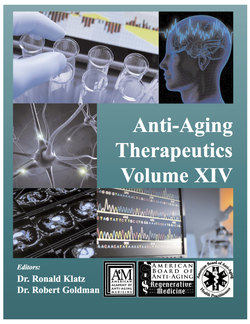Читать книгу Anti-Aging Therapeutics Volume XIV - A4M American Academy - Страница 69
REFERENCES
Оглавление1.Rosenfeld L. Discovery and early uses of iodine. Journal of Chemical Education. 2000;77:984.
2.Braverman LE, Utiger RD, eds. Werner & Ingbar's The Thyroid: A Fundamental and Clinical Text. 8th ed. Philadelphia, Pa: Lippincott, Williams & Wilkins;2000.
3.Kelly FC. Iodine in medicine and pharmacy since its discovery – 1811-1961. Proc R Soc Med. 1961;54:831-836.
4.Wilford J. Neanderthal or cretin. A debate over iodine. New York Times. December 1, 1998.
5.Preedy V, Burrow G, Watson R, eds. Comprehensive Handbook of Iodine Nutritional, Biochemical, Pathological, and Therapeutic Aspects. Academic Press; 2009. Kindle Edition. Location 2769.
6.Preedy V, Burrow G, Watson R, eds. Comprehensive Handbook of Iodine Nutritional, Biochemical, Pathological, and Therapeutic Aspects. Academic Press; 2009. Kindle Edition. Location 2740.
7.Preedy V, Burrow G, Watson R, eds. Comprehensive Handbook of Iodine Nutritional, Biochemical, Pathological, and Therapeutic Aspects. Academic Press; 2009. Kindle Edition. Location 2810.
8.Stipanuk MH. Biochemical, Physiological & Molecular Aspects of Human Nutrition. 1st ed. Elsevier Health Sciences;2000:763.
9.Eng PH, Cardona GR, Fang SL, et al. Escape from the acute Wolff-Chaikoff effect is associated with a decrease in thyroid sodium/iodide symporter messenger ribonucleic acid and protein. Endocrinology. 1999;140:3404-3410.
10.Stipanuk MH. Biochemical, Physiological & Molecular Aspects of Human Nutrition. 1st ed. Elsevier Health Sciences;2000:772.
11.Stipanuk MH. Biochemical, Physiological & Molecular Aspects of Human Nutrition. 1st ed. Elsevier Health Sciences;2000:764.
12.Preedy V, Burrow G, Watson R, eds. Comprehensive Handbook of Iodine Nutritional, Biochemical, Pathological, and Therapeutic Aspects. Academic Press; 2009. Kindle Edition. Location 2450.
13.Stipanuk MH. Biochemical, Physiological & Molecular Aspects of Human Nutrition. 1st ed. Elsevier Health Sciences;2000:762.
14.Stipanuk MH. Biochemical, Physiological & Molecular Aspects of Human Nutrition. 1st ed. Elsevier Health Sciences;2000:779.
15.Zagrodzki P, Szmigiel H, Ratajczak R, Szybinski Z, Zachwieja Z. The role of selenium in iodine metabolism in children with goiter. Environ Health Perspect. 2000;108:67-71.
16.Vanderpas J. Nutritional epidemiology and thyroid hormone metabolism. Annu Rev Nutr. 2006;26:293-322.
17.Pearce EN, Pino S, He X, Bazrafshan HR, Lee SL, Braverman LE. Sources of dietary iodine: bread, cows' milk, and infant formula in the Boston area. J Clin Endocrinol Metab. 2004;89:3421-3424.
18.Müssig K, Thamer C, Bares R, Lipp HP, Häring HU, Gallwitz B. Iodine-induced thyrotoxicosis after ingestion of kelp-containing tea. J Gen Intern Med. 2006;21:C11-14.
19.Sumar S, Ismail H. Iodine in food and health. Nutrition & Food Science. 1997;97:175-183.
20.Gomo ZA, Allain TJ, Matenga JA, Ndemere B, Wilson A, Urdal P. Urinary iodine concentrations and thyroid function in adult Zimbabweans during a period of transition in iodine status. Am J Clin Nutr. 1999;70:888-891.
21.Nyiri W, Jannitti M. About the fate of free iodine upon application to the unbroken animal skin. J Pharmacol Exp Ther. 1932;45:85-107.
22.Biskind MS. Penetration through tissue of iodine in different solvents. Proc Soc Exp Biol Med. 1932;30:35-37.
23.Hollowell JG, Staehling NW, Hannon WH, et al. Iodine nutrition in the United States. Trends and public health implications: iodine excretion data from National Health and Nutrition Examination Surveys I and III (1971-1974 and 1988-1994). J Clin Endocrinol Metab. 1998;83:3401-3408.
24.Caldwell KL, Jones R, Hollowell JG. Urinary iodine concentration: United States National Health and Nutrition Examination Survey 2001-2002. Thyroid. 2005;15:692-699.
25.Block SS. Disinfection, sterilization, and preservation. 5th ed. Hagerstwon, MD: Lippincott Williams & Wilkins; 2000.
26.Toxicological Profile for Iodine. Agency for Toxic Substances and Disease Registry Web site. http://www.atsdr.cdc.gov/ToxProfiles/tp.asp?id=479&tid=85. Accessed February 9, 2012.
27.National Research Council. Dietary Reference Intakes for Vitamin A, Vitamin K, Arsenic, Boron, Chromium, Copper, Iodine, Iron, Manganese, Molybdenum, Nickel, Silicon, Vanadium, and Zinc. Washington, DC: The National Academies Press; 2001:258-289.
